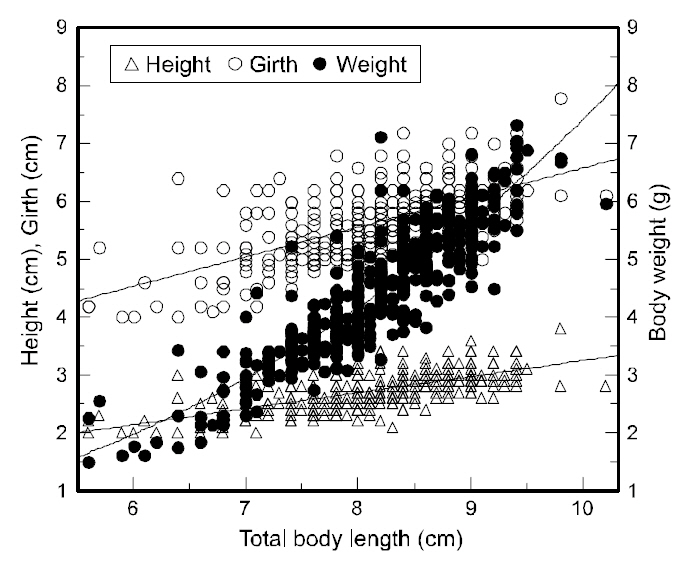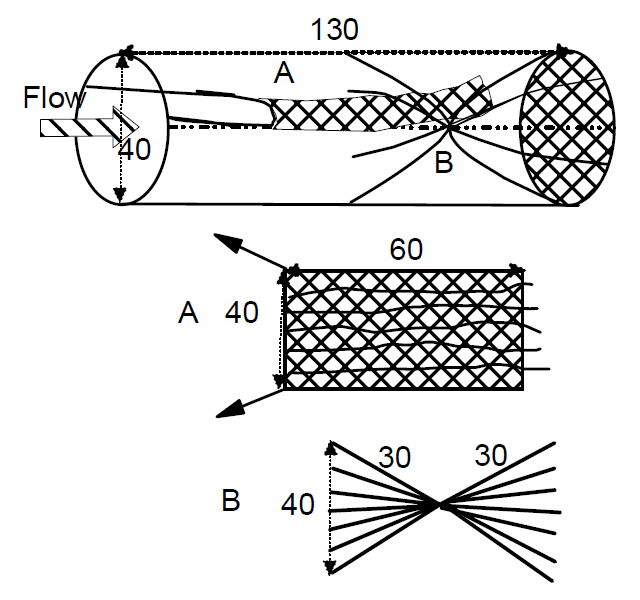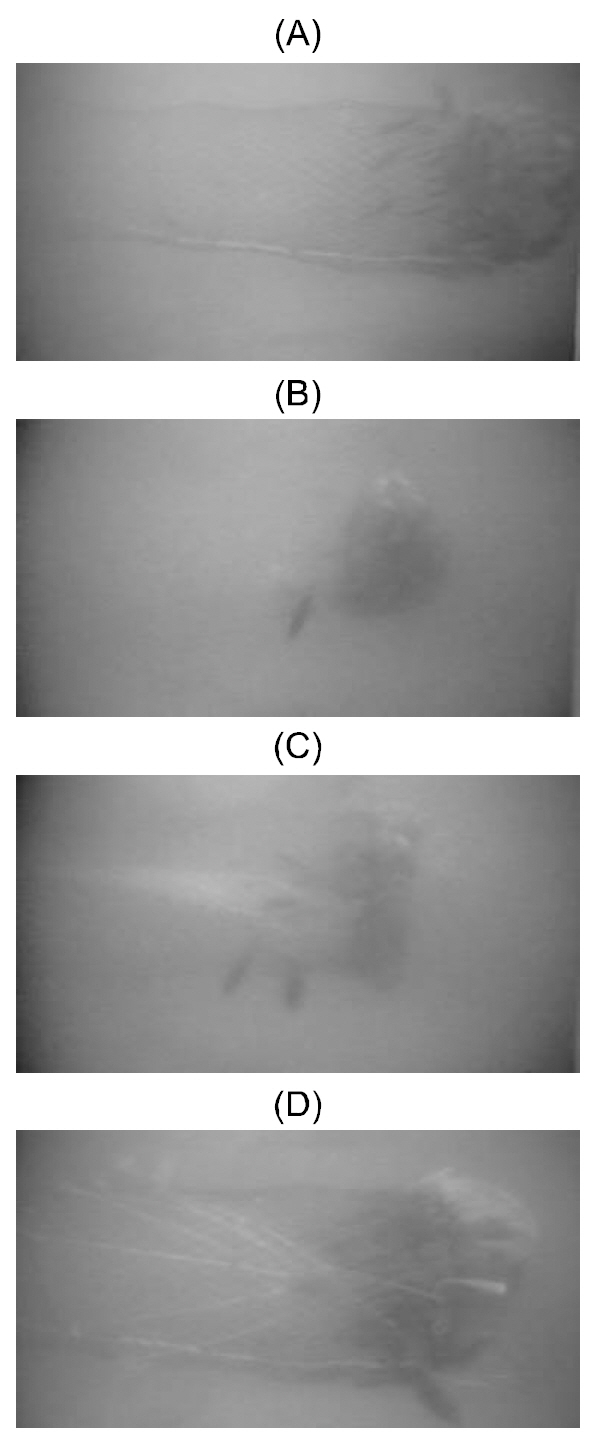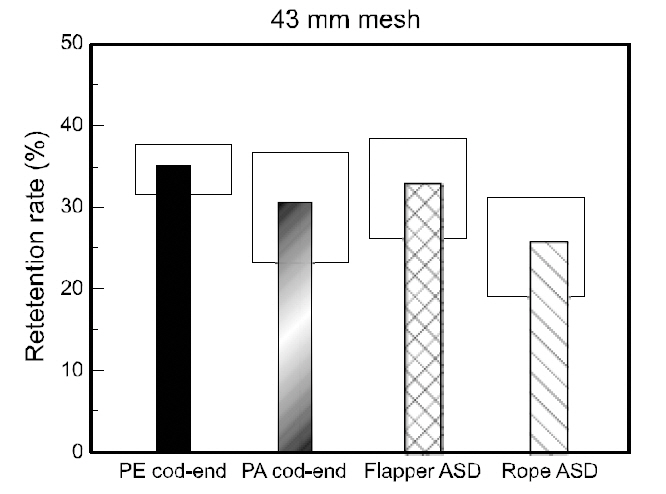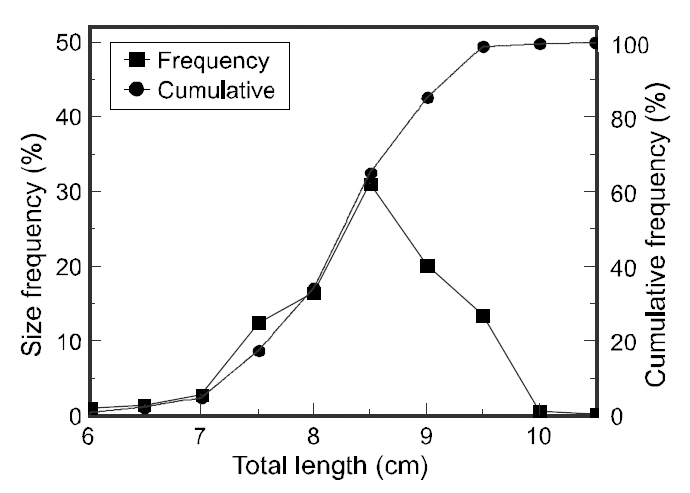


Reduction of bycatch and discards is a very important issue in many selective fisheries and has been promoted to facilitate the responsible exploitation of aquatic resources for many decades through international conferences (FAO, 1995). A square-mesh window in the cod end had been investigated as a means of reducing the bycatch of flatfish, as well as most roundfish (Fonteyne and M'Rabet, 1992; Madsen et al., 2006), and has been adopted as selective regulation in many European countries (Borges, 2009). Several trials have been conducted to examine the effectiveness of separating the net panels (Horie et al., 2001; Miyajima et al.,2007) and placing black canvas on the cod end to replicate predator effects (Glass and Wardle, 1995).Grid-separator bycatch-reduction devices also have been widely studied and used in shrimp fisheries,especially in Australia (Andrew et al., 1993).
However, the square-mesh window has been shown to be less effective for flatfish (Petrakis and Stergiou, 1997), and the grid separator has more problems with rigidity than do netting or ropes(Loaec et al., 2006). Bycatch reduction, especially attempts to reduce juvenile bycatch for conservation purposes, has not reached a satisfactory level(Graham et al., 2004) despite many trials using combinations of square-mesh windows and grid separators. Accordingly, the international guidelines on bycatch reduction are in the process of implementing management measures to reduce bycatch,including modifications to fishing gear such as bycatch reduction devices (Chopin and Suuronen,2009).
Exhausted fish that have been herded from the mouth of the towed gear to the cod ends of nets rarely attempt to approach the net and use opercular jetting(Brainerd et al., 1997) to penetrate the mesh and escape from the cod end (Albert et al., 2003; Ryer,2008). Therefore, strategies used to increase fish escape from the cod end first involves encouraging fish to attempt to approach the netting, i.e.,interfering with the optomotor swimming response(Kim and Whang, 2010). However, the existing square-mesh window and grid methods are static, passive stimuli that do not change position with short towing periods. An alternative method is the so-called active stimulating device (ASD), which may take the form of a conical rope array, rotating rope kite, or fluttering net panel inside the cod end that generates variable visual stimuli for juvenile fishes in addition to flow-related effects (Kim, 2010). From the first ASD trial, the retention rate of juvenile red seabream was sig-nificantly lower using an ASD cod end,including an attached fluttering net panel and a flaglike rope array, than with conventional cod ends (Kim and Whang, 2010).
Fish behavioral response to the cod end vary by species, body shape, and body size, with physiological and ecological conditions as biological factors (Graham et al., 2004). Response also varied with the selection of towed fishing gear, with mesh size, mesh shape, cod end size, construction, etc. as physical factors. Thus, we investigated the effects of an ASD cod end using juvenile flatfish in tank experiments as a preliminary test.
Flatfish, which utilize a seabed-based habitat, show quite different responses than do many round fish during herding, net entry, and passage during fishing operations (Hannah et al., 2005; Ryer, 2008). These differences result from the body shape of flatfish and the constraints that this morphology place upon their natural predator avoidance and evasion tactics.Additionally, the maximum sustained swimming speeds and endurance of flatfish, which use up and down beating movements, were found to be lower than those of most round fish, which beat with right and left movements (Winger et al., 2004). Flatfish vision is also poor due to the small pupils and eye position, with an upper-limited viewing angle (Furuse and Fukurotani, 1999; Matsuda et al., 2009).Naturally, flatfish net penetration could be affected by control of the escaping body posture in relation to mesh shape and position, as shown in flatfish responses to a grid (Matsushita et al., 2004; Rose and Gauvin, 2000). However, to date, no observations of flatfish escape responses from the cod end have been reported using quantitative analysis.
The objective of this study was to clarify the effects on juvenile flatfish of ASD cod ends compared with a conventional cod end without ASD. For the design of ASDs for flatfish, two behavioral aspects were considered. First, although a fluttering net panel was an effective stimulating device for seabream, flatfish could settle on the panel due to their sea floor habitat (Kim and Whang, 2010).Second, the fact that flatfish have been easily herded by sweep lines could be applied in reverse to use ropes to drive fish from the cod end, as shown in a preliminary test for black porgy (Kim, 2010). As a first test, the escape responses of juvenile bastard halibut were observed in a circulating water channel using ASD and conventional cod ends, and retention rates were compared.
Approximately six thousand juvenile bastard halibut Paralichthys olivaceus aged about 3 months and 8.2±0.7 cm in mean total length, 2.8±0.4 cm in mean height, 5.6±0.6 cm in mean girth, and 4.5±1.1 g in mean body weight were purchased from a fish hatchery in Geoje, Korea on October 30, 2009, for use in the experiment. The sizes of 430 individuals are plotted in Fig. 1.
The relationships between total body length (BL,cm) and height (H, cm), girth (G, cm), and weight (W,g) of the bastard halibut were as follows:
H=0.28 BL+0.47 (r2 = 0.46)
G=0.51 BL+1.46 (r2 = 0.46)
W=0.0189 BL2.6 (r2 = 0.81)
Fish were reared in a net cage (7.0 [L]× 7.0 [B]×5.0 [D] m) located at the training-ship pier of the College of Marine Science (Gyeongsang National University), Tongyoung. From November 9, 2009,fish were transferred to a 3-m-diameter water tank that formed the central part of a 5-m-diameter bluecolored FRP circular tank (Kim and Whang, 2010)located in the College of Marine Science, Tongyoung. Fish were fed with aquaculture pellets once a day.Seawater in the tank was filtered through 300 L sand and a filter system by two underwater pumps (Hanil Electronics PS-225, 220V, 1/3 hp), with complete changeover of seawater every 10 days. Water temperature varied from 14 to 16°C, and salinity was 34 psu during November 10-24, 2009, as measured by a handheld meter (YSI, Inc., 85FT). Experiments were carried out following the Korean law for the Ethical Use of Animals in Research.
The conventional-model cod end (reef knot,diamond mesh) had a diameter of 40 cm and a length of 130 cm, with a hanging ratio of 87% and mesh size of 43-mm, and it was made of dark brown PE(monofilament, Ø 0.5-mm) with five circular ring frames formed by iron wires (Ø0.2 mm), as shown in Fig. 2. However, the front and rear round panels were made of 10-mm-mesh-size white PA Raschel netting(multifilament, Ø 0.5-mm), which did not allow juvenile bastard halibut to pass through.
The rectangular (60×40 cm) fluttering net-panel ASD was made of white PA Raschel net (multifilament,Ø 0.5 mm) with a hanging ratio of 97%,which was attached to the frontal ends of 11 pieces of braided white PA twine (multifilament, Ø 3.5 mm)(Kim and Whang, 2010). The ends of the twine were fixed to the upper third of the wire ring. Another horizontal rope array (length 70 cm) was made of 11 pieces of braided white PA twine (multifilament,Ø3.5 mm) in a row attached to a curved twine fixed by its two ends to points at the lower third of the cod end, as shown in Fig. 2(A).
The ASD cod end with a double conical rope array consisted of 11 pieces of white braided PA twine(Ø3.5 mm, length 30 cm) fixed by each end to the middle and rear wire rings in the conventional-model PE cod end, as shown in Fig. 2(B). A low-contrast cod end constructed of PA monofilament netting(mono-ply, reef knot, diamond mesh size 43 mm) was made using Ø 0.5 mm twine of light green color.
The model cod end was set up in the outer channel of the circular water tank, as in Kim and Whang(2010). Three underwater pumps (Hanil Electronics,IPV-835, 220V 1 hp) generated a mean water flow of 0.6-m/s (measured by Marsh McBirney 201D).Experiments were carried out using model cod ends either with or without the fluttering net or rope array.The illumination of the water tank, located in an outdoor site, was adjusted to about 100 lx, as measured by an underwater illumination meter (Topcon IM-5), by covering the tank with canvas. The optical characteristics of the seawater in the tank were measured as the vertical absorption coefficient and beam attenuation coefficient by an AC9+ (Wet Lab)transmission meter. The optical properties of the seawater ranged in vertical absorption coefficient from c=0.51 to 0.59 and in beam attenuation coefficient from k=1.25 to 1.37 at wavelength 510-532 nm (blue-green).
For each experiment, a group of two hundred fish was released from a vinyl bag during water flow at the front of the cod end. Fish behavior was observed by underwater video cameras (Simrad OE 1210,Huhu UWC-150VH-N) and VTR (Samsung WR-1000) for 30 min. Then, fish retained in the cod end were removed to a resting water tank for counting.Size of dead fish among those retained was measured from the mesh size. Each experiment was repeated 10 times for the conventional PE cod end, ASD cod end with fluttering net, ASD with a conical rope array,and low-contrast PA cod end using random groups of;experiments were separated by at least 2-day intervals,as shown in Table 1.
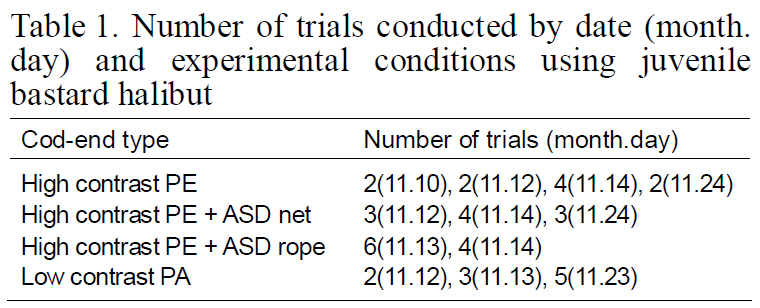
Number of trials conducted by date (month.day) and experimental conditions using juvenile bastard halibut
Inherent contrasts of the nets used in these experiments were estimated from Kim and Wardle(1998) as high contrast of 1.38 for the brown PE netting (Ø0.5 mm) and low contrast of 0.41 for the light green PA netting (Ø0.5 mm) at 100 lx.
Video images of the four kinds of cod end, i.e.,conventional PE netting, fluttering net-panel ASD,double conical rope-array ASD, and low-contrast PA netting, are shown in Fig. 3. The side net panel of the transparent PA-netting cod end was not seen by the SIT video camera due to its low contrast with the background of the water tank, whereas the side net panel of the conventional PE-netting cod end was clearly seen. The fluttering net panel flapped up and down like a flag in the turbulence inside the cod end,similar to the movements observed in seabream experiments (Kim and Whang, 2010).
From the video observations, flatfish were frequently observed swimming steadily just above the fluttering horizontal net panel, presumably as an optomotor response to their usual sea-floor behavior.This flatfish response might have been facilitated by the slow water flow speed of 0.6 m/s compared with 0.8-m/s in the seabream experiments. Therefore,further experiments using a vertical net panel,fluttering from left to right at high flow speed, as an ASD may be necessary.
From the video observations, flatfish were frequently observed swimming steadily just above the fluttering horizontal net panel, presumably as an optomotor response to their usual sea-floor behavior.This flatfish response might have been facilitated by the slow water flow speed of 0.6 m/s compared with 0.8-m/s in the seabream experiments. Therefore,further experiments using a vertical net panel,fluttering from left to right at high flow speed, as an ASD may be necessary.
The number of escaping juvenile bastard halibut decreased with increases in elapsed towing time due to fish exhaustion, and the number of retained fish decreased as a space effect. After 30 min, about 5-10% of 200 fish remained at the rear panel of the cod end in an exhausted state. The diameter of the model cod end was about 5 times the mean body length of 8.3 cm and about 15 times the mean body height, and the length of the model cod end was about 16 times the mean body length. The 200 fish initially released in this study could thus form a 6×6×6 formation in the space. Therefore, the number of fish used in each experiment and the scale effects of the cod ends in this experiment were regarded as nearly mimicking real conditions in field operations
Space effects on escape or selectivity have been reported, in that narrow cod ends with smaller circumference or high densities of catch increased fish escape (Broadhurst and Millar, 2009; Graham et al., 2009). Additionally, differences have been revealed between the escape responses of natural flatfish and hatchery-reared bastard halibut (Miyazaki et al., 2004) and under different light conditions and
temperatures (Ryer and Barnett, 2006). Further study of ASDs using full-scale cod ends should be conducted in the field, with consideration of flow turbulence, scale effects of the cod end, behavioral aspects, etc. (Somerton et al., 2007).
Average cycle time of the fluttering net panel inside the cod end at a mean water flow of 0.6 m/s based on 20 measurements for 20 cycles was about 3.0±0.4 s, ranging between 2.5 and 3.9 s. Average amplitude of the upper and lower limit of the fluttering device was about 20±5-cm, with high variation caused by the complex turbulent flow inside the cod end. The period of the fluttering net panel at the water flow of 0.6 m/s used in this experiment was slightly longer than that at 0.8-m/s, whereas the amplitude at 0.6 m/s was shorter than that at 0.8 m/s,based on previous results (Kim and Whang, 2010).
The fluttering motion of the ASD was affected by turbulence around the cod end. The turbulence inside the cod end in the experimental water channel used in this study showed an estimated rate of 12-17%, as measured by 3-D flow velocimeter (Vector), which was similar to the measured turbulence rate of 8-17%from the model cod end in a flume tank (Pichot et al.,2009).
The fluttering period of the active net panel in this experiment (2.5-3.9-s) could affect swimming patterns in the cod end. The dominant period of swimming acceleration for flatfish near ground gear during field operations was 3.7 s during the fallingback response and 2.1 s during the herding response(Kim and Wardle, 2006). Therefore, the variable period of the fluttering net panel could disturb the orderly pattern of swimming fish, especially the acceleration time of the juvenile flatfish. The fluttering frequency as a reciprocal of the period and amplitude as a ratio of the flapping span to the chord of a flag was estimated in air and in water (Shelley et al., 2005) and also was derived by theoretical and empirical equations (Watanabe et al., 2002) as a function of flag dimensions. However, the fluttering motion of active net panels attached in full-sized cod ends should be investigated in field experiments.

Average retention numbers with S.D of juvenile bastard halibut in the conventional high contrast PE cod-end the low-contrast PA netting cod-end the ASD fluttering net panel in the PE cod-end and the ASD conical rope array in the PE cod-end

The results of a Student’s t-test and F-test for retention rates between the conventional high contrast PE cod-end the low-contrast PA netting cod-end the fluttering net panel in the PE cod-end and the conical rope array in the PE cod-end
The twines of the conical rope array in the PE cod end showed slight hogging in the forward array and sagging in the rear array. In the double conical ropearray ASD, the angle of attack of each rope was about 40° as a diagonal, similar to the angle of the foot rope used to sweep flatfish. Additionally, each rope generated slight oscillation from its lifting force or from the turbulent flow in the cod end. Therefore, the shape and position of the rope array in the cod end affected the clear pathway of fish swimming by disturbing the optomotor response due to the sweeping effect and creating a space-lacking effect with visual, flow, and contact stimuli, etc. Additionally, the frontal-view image of the diagonal rope array could be seen as a different contrast for fish eyes and provided no clear fixed object for maintaining the optomotor response.
The mean retention numbers (with S.D.) of juvenile bastard halibut in ASD cod ends and in the conventional cod end with PE netting as high contrast and PA netting as low contrast with 43-mm mesh size are presented in Table 2 and Fig. 4 as retention rates.
The retention rate of juvenile bastard halibut with the double conical rope-array ASD was significantly lower (about 7-10% by Student’s t-test) than that with conventional PE cod ends or with the fluttering netpanel ASD, as shown in Table 3. The mean retention rate with the low-contrast PA cod end was also significantly lower than with the conventional highcontrast PE cod end. The retention rate was not different between the other pair of cod ends. The retention rate of juvenile bastard halibut was not different between the fluttering net-panel ASD and the conventional PE cod end without ASD, although significant effects were found for juvenile seabream
(Kim and Whang, 2010). Under relatively bright conditions, the absolute retention rates of juvenile bastard halibut were lower than those of juvenile red seabream. The reason for these differences may have included different water temperatures and flow speeds as well as the different body types of the species.
Retention rate of plaice in Norway lobster trawls(Madsen et al., 2010) was 17-23% using an escape window, which is lower than the 25-35% recorded in the present experiment. However, the rate of flatfish(Lepidorhombus boscii) retained in Mediterranean trawls (Petrakis and Stergiou, 1997) was 66% in diamond mesh and 90% in square mesh, both of which are higher than that recorded in the present experiment. Therefore, the effects of ASDs on juvenile flatfish bycatch in shrimp beam trawls or bottom trawls must be investigated in the field in the future.
Retention rates of juvenile bastard halibut in relation to total body length with the 43-mm cod end for all experiments are shown in Fig. 5. Selectivity of fish size at 50% retention of juvenile bastard halibut was estimated to be 8.3 cm in 43-mm mesh netting,although the maximum girth of the juvenile bastard halibut was smaller than the mesh perimeter.
The eyes of bastard halibut are sensitive to greencolor wavelengths of 520-540 nm (Thanapatay and Fukurotani, 2003; Matsuda et al., 2008), and their brightness-contrast threshold under experimental conditions was estimated as 0.05 (Kim, 1998). Thus,juvenile bastard halibut in this study may have been able to see almost all of the nets and ropes, but the
brightness contrast of the rope array was much stronger than that of the nettings due to the white color and thickness of the ropes. This stimulus might have had a greater effect in the double conical rope array than in the fluttering net-panel ASD.Accordingly, the conical rope array could drive fish,herding them sideward and giving them a greater chance of passing through the mesh.
Maximum swimming speed of juvenile bastard halibut easily reaches more than 20 BL/s (Videler and Wardle, 1991). The water-flow velocity of 0.6 m/s in this experiment equated to about eight BL/s for juvenile bastard halibut, and their endurance has been estimated at more than 25-min (Hashimoto et al.,1996; Kim and Wardle, 1997; Winger et al., 1999).Therefore, the relative flow velocity of 0.6 m/s was regarded as reasonable in relation to a bottom trawl towing speed of 1.5 m/s, considering the swimming speed and endurance of 20-cm juvenile bastard halibut under natural conditions (He, 2003; Kawabe et al., 2004).
The escape of juvenile bastard halibut from the low-contrast cod end with green PA netting was about 7% higher than that from the high-contrast cod end with dark brown PE netting in this study, but it was found to be 16% higher in red seabream experiments(Kim and Whang, 2011). In addition to the effects of the different body shapes of bastard halibut and red seabream, the differences in these values may have originated from differences in water temperature and light conditions. However, the results of our experiments,using the same thickness of twine, clearly confirmed the high escape of juvenile fish from lowcontrast netting twine as a low visibility stimulus, as has also been demonstrated in seine-net experiments (Gray et al., 2000).
Studies of fish escape behavior from cod ends in the North Sea showed that more strikes or approaches to nets yield more escapes (Jones et al., 2008; Kim et al., 2008). Fish that show approaching or striking behaviors are exhibiting erratic responses, in contrast to the optomotor response of maintaining swimming speed and position (Wardle, 1993; Kim and Wardle,2006). Increased erratic responses and reduced optomotor responses caused by ASDs could encourage fish to approach the netting, facilitating their passage through less visible side netting in the cod end.Therefore, low-contrast netting with an ASD in the cod end could help to reduce juvenile bycatch by disrupting the optomotor response and by providing a clear path. Further study should be focused on different light levels, flow speeds, and temperatures in tank experiments for later application to field experiments using full-scale fishing gear.
